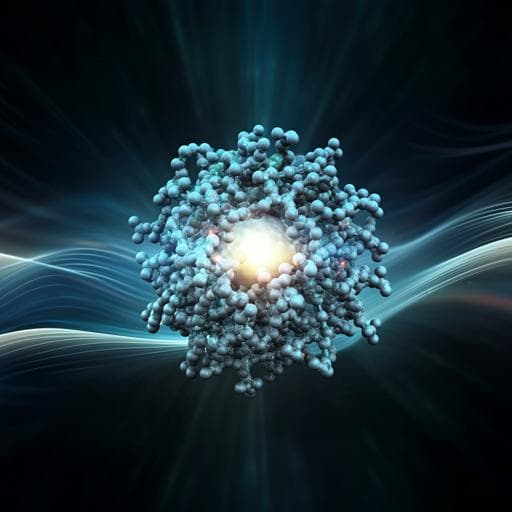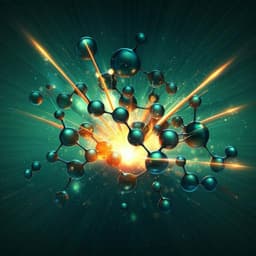
Engineering and Technology
Efficient and sustainable water electrolysis achieved by excess electron reservoir enabling charge replenishment to catalysts
G. R. Lee, J. Kim, et al.
Discover groundbreaking advancements in water electrolysis with research conducted by Gyu Rac Lee, Jun Kim, Doosun Hong, Ye Ji Kim, Hanhwi Jang, Hyeuk Jin Han, Chang-Kyu Hwang, Donghun Kim, Jin Young Kim, and Yeon Sik Jung. This study reveals how an excess electron reservoir dramatically enhances the stability of active-Ir(III) in IrOₓ catalysts, achieving an astounding 75 times higher mass activity than commercial options—paving the way for gigawatt-scale hydrogen production!
~3 min • Beginner • English
Introduction
The study addresses a key challenge in polymer electrolyte membrane water electrolysis (PEMWE): sluggish oxygen evolution reaction (OER) kinetics in acidic media that necessitate high Ir loadings and cause large overpotentials and durability issues. While IrOₓ formed during activation exhibits higher OER activity than metallic Ir or IrO₂, the most active Ir(III) species tends to oxidize to Ir(IV/V) under OER, forming soluble intermediates that lead to Ir dissolution and performance degradation. Prior efforts largely optimized activity without adequately addressing deterioration and durability. A promising path is to sustain active Ir(III) via continuous charge replenishment from the support, but conventional metal oxides exhibit limited charge transfer due to their electronic structure, and defect engineering via oxygen vacancies can cause instability from cation leaching and structural collapse. This work proposes an excess electron reservoir (EER) strategy that forms an electron-donating layer on a metal oxide support to preserve Ir(III) under OER conditions. Using antimony-doped tin oxide (ATO) as the support and charged-oxygen groups (O⁻/O₂⁻) as the EER, the authors hypothesize that enhanced, sustainable charge donation from the EER will stabilize Ir(III), thereby overcoming the activity–durability trade-off.
Literature Review
Ir-based catalysts remain state-of-the-art for OER in acidic PEMWE, but high cost and loading levels hinder commercialization. IrOₓ activity correlates linearly with the fraction of Ir(III), yet Ir(III) oxidizes during operation, yielding soluble intermediates and dissolution. Stronger catalyst–support interactions on oxides such as TiO₂, Nb-doped TiO₂, and TiO₂–MoOₓ have shown improved OER activity and durability via enhanced charge transfer, but such effects are often composition-specific and limited by inherent electronic structures. Oxygen vacancies can raise electron density and improve charge transfer but risk structural instability through cation leaching and slow vacancy compensation, leading to collapse. These findings motivate a more universal and sustainable support design to boost charge transfer and stabilize Ir(III) without structural degradation.
Methodology
Design and screening of EER materials: Density functional theory (DFT) screening evaluated potential EER candidates on ATO using three criteria: processability (electron-rich nonmetals with high electron affinity), structural stability via adsorption energy (Eads), and charge transfer capability to IrOₓ. Nine nonmetal atomic/diatomic species and oxidation states (B, N, O, F, P, S, N₂, O₂, F₂; charges 0 to −3) were assessed. Candidates with Eads > 0 or charge transfer < 0.10 e were excluded, leaving charged oxygen species (O⁻, O₂⁻) and F, with charged oxygen chosen for in situ process compatibility during ATO deposition.
Fabrication of EER-containing supports and catalysts: SnOₓ was e-beam evaporated to create oxygen-rich layers, evidenced by XPS depth profiling showing an O-rich bottom ~5 nm and Raman features at ~1100–1200 cm⁻¹ assigned to O₂⁻ species. The oxygen content (EER density) was tuned by the e-beam deposition start time (shutter timing). Sb was added as an n-dopant to form conductive ATO. Three supports with varying EER densities were prepared: sparse (S-ATO), moderate (M-ATO), and dense (D-ATO), quantified by XPS O/Sn and Sn satellite/Sn ratios.
Nanostructure assembly (S-nTP) and annealing: Using solvent-assisted nanotransfer printing (S-nTP), oblique-angle e-beam deposition (80° tilt) sequentially placed Ir, Sb, and SnO₂ onto a PMMA replica from a line-patterned master. Deposited nanowire arrays were transfer-printed onto Cu foil, stacked perpendicularly to form 3D woodpile architectures, and annealed at 700 °C for 2 h in Ar to crystallize ATO and form spherical Ir nanoparticles (2–10 nm) distributed on ATO. The oxygen-rich EER was incorporated by controlling SnOₓ deposition timing. After Cu wet etching (0.1 M ammonium persulfate), structures were transferred to glassy carbon (half-cell) or Nafion membranes (single cell).
Characterization: Morphology and structure were analyzed by SEM, TEM (including HRTEM, SAED), HAADF-STEM/EDX mapping, Raman, and XRD. XPS quantified elemental compositions and Ir oxidation states (deconvolution of Ir 4f into metallic Ir, Ir(III), Ir(IV); C 1s at 284.8 eV for calibration). ICP-MS quantified Ir loading and dissolution.
Electrochemical half-cell tests: Conducted in 0.05 M H₂SO₄ (Ar-saturated) using an RDE setup (glassy carbon 0.196 cm² working electrode, Pt mesh counter, Ag/AgCl reference; potentials converted to RHE). Activation CV: 0.05–1.4 V at 200 mV s⁻¹ until Ir formed hydrated oxide. LSV: 1.2–1.7 V at 5 mV s⁻¹, 1600 rpm. EIS at 1.55 V_RHE (1 Hz–100 kHz). Chronopotentiometry stability at 1 and 10 mA cm⁻² (glassy carbon for 1 mA cm⁻²; Ti plate for 10 mA cm⁻²). Accelerated durability test (ADT): 1.2–1.6 V cycling at 50 mV s⁻¹. ECSA determined by CO stripping (0.7–1.15 V peak area normalized by 420 µC cm⁻²). Commercial references included Ir black and Ir/C; Ir/CNW (carbon nanowire support) matched the 3D architecture for comparison.
DFT calculations: Performed with VASP (plane waves, 400 eV cutoff), PAW method, PBE-GGA exchange-correlation, Monkhorst-Pack k-point meshes (2×2×1 for smaller ATO(110) 2×2×3 trilayer slabs; 1×2×1 for larger 2×4×5 trilayer slabs, 20 Å vacuum). O₂⁻ anion side-on adsorption between two Sn atoms on ATO(110) was modeled; O₂⁻ concentrations (1O₂ to 4O₂) simulated EER density. Model catalyst: Ir₄O₈ cluster on EER-ATO slabs (8 wt% Sb). Charge transfer visualized along the c-axis; Bader charge analysis quantified Ir/O charge states versus O₂⁻ density. Control calculations with neutral O₂ assessed effects of non-anionic oxygen species.
PEMWE single-cell tests: MEAs (1 cm², Nafion 212) used Ir/D-ATO as anode (low loading 7.2 µg_Ir cm⁻²; also tested 47.5 µg_Ir cm⁻² for durability) and Pt/C cathode (0.1 mg_Pt cm⁻²). Comparators: Ir black and Ir/TiO₂ at 0.01 and 0.5 mg_Ir cm⁻². Operation at 80 °C, ambient pressure, DI water feed to anode (15 mL min⁻¹). EIS at 1.5 V (10¹–10⁵ Hz, 10 mV). Mass activity and Ir-specific power were benchmarked against literature.
Key Findings
- EER identification and incorporation: DFT screening selected charged oxygen species (O⁻, O₂⁻) as stable, high-charge-donation EERs on ATO. E-beam deposition created oxygen-rich SnOₓ layers with Raman O₂⁻ signatures (1100–1200 cm⁻¹). XPS confirmed higher O/Sn and Sn satellite/Sn ratios with increasing EER density (D-ATO O/Sn 0.94 vs M-ATO 0.569, S-ATO 0.401).
- Catalyst structure: Ir nanoparticles (2–10 nm) were uniformly distributed on D-ATO nanowires; post-annealing crystallinity improved with dominant Ir(111) and ATO(110) planes (TEM/SAED/HRTEM, XRD). As-synthesized Ir/D-ATO Ir oxidation states (XPS): metallic Ir 55.10%, Ir(III) 4.92%, Ir(IV) 39.28%.
- Half-cell OER activity: Ir/D-ATO mass activity reached 5.975 A mg_Ir⁻¹, ~11× higher than Ir black (0.533 A mg_Ir⁻¹) and Ir/C (0.510 A mg_Ir⁻¹). Specific activity exceeded all references, including Ir/CNW with similar ECSA, indicating intrinsic activity enhancement from EER. EIS showed significantly reduced charge-transfer resistance for Ir/D-ATO versus Ir/C, Ir black, and Ir/CNW.
- Influence of EER density: Among Ir/D-ATO, Ir/M-ATO, Ir/S-ATO (dense, moderate, sparse EER), activity increased with EER density. Tafel slopes: 49.05 mV dec⁻¹ (D-ATO), 51.40 mV dec⁻¹ (M-ATO), 59.33 mV dec⁻¹ (S-ATO). Stability trends paralleled activity improvements.
- Durability and dissolution: Under 1 mA cm⁻², Ir/D-ATO showed no degradation over >20 h, outperforming Ir/C, Ir/CNW, and Ir black, which degraded within 7–10 h. At 10 mA cm⁻² (Ti plate substrate), Ir/D-ATO retained activity ~18 h; Ir/C degraded immediately, Ir black within <3 h. ICP-MS after 15 h at 1 mA cm⁻² indicated ~21.3% Ir mass loss. EER-driven charge replenishment is implicated in suppressing Ir oxidation and dissolution.
- XPS across stages and DFT charge analysis: After activation, Ir(III) fraction and Ir(III)/Ir(IV) ratio increased with EER density; Ir/D-ATO had Ir(III) 20.69% and Ir(III)/Ir(IV)=0.563 (~1.44× and 1.77× those of M-ATO and S-ATO). After ADT, Ir/D-ATO Ir(III)/Ir(IV) increased to 0.757, whereas lower-EER samples decreased. DFT showed electron donation from ATO to Ir₄O₈ increases with O₂⁻ concentration, lowering Ir charge states (favoring metallic Ir and Ir(III)). Neutral O₂ exhibited no such effects.
- PEMWE single-cell performance: With ultra-low Ir loading (7.2 µg_Ir cm⁻²), Ir/D-ATO outperformed commercial Ir/TiO₂ and Ir black; mass activity at 1.6 V was 55× and 75× higher than their high-loaded (0.5 mg_Ir cm⁻²) counterparts. At 47.5 µg_Ir cm⁻², Ir/D-ATO sustained 1 A cm⁻² for >250 h with only 0.624 mV h⁻¹ degradation; at 0.5 A cm⁻², 500 h with 0.184 mV h⁻¹. The Ir-specific power reached 74.8 kW g⁻¹ at ~87% efficiency (1.6 V), surpassing prior Ir-based PEMWE catalysts and meeting targets projected for gigawatt-scale H₂ production.
Discussion
The results validate the hypothesis that a surface-engineered excess electron reservoir on ATO supports can sustainably donate charge to IrOₓ catalysts, stabilizing the catalytically active Ir(III) state during OER. Enhanced charge transfer from EER-containing supports reduces the oxidation of Ir(III) to higher valence states that promote dissolution, thereby simultaneously improving activity and durability. XPS trends (higher Ir(III) fractions and increasing Ir(III)/Ir(IV) after activation and ADT with higher EER density) and DFT (greater electron transfer and reduced Ir charge states with increased O₂⁻) directly connect EER density to Ir oxidation state control. Electrochemically, lower Tafel slopes, reduced charge-transfer resistance, and superior mass and specific activities demonstrate improved intrinsic kinetics and interfacial electron transport. In PEMWE cells, the combination of EER-driven intrinsic enhancement and 3D connected architectures yields high performance even at ultra-low Ir loadings, translating into record Ir-specific power and durable operation at industrially relevant current densities. Compared to prior approaches (complex oxide compositions or oxygen vacancies), EER formation offers a universal and stable route to boost charge transfer without compromising structural integrity.
Conclusion
This work introduces an excess electron reservoir strategy—charged oxygen species integrated on ATO supports—to engineer catalyst–support interactions that replenish charge to IrOₓ and stabilize Ir(III) during OER. The approach delivers record Ir-based performance: highest mass activity among oxide-supported Ir catalysts, outstanding PEMWE durability at low Ir loadings, and an Ir-specific power of 74.8 kW g⁻¹ at ~87% efficiency. Joint XPS and DFT analyses show that increasing EER density enhances electron donation and maintains lower Ir charge states, breaking the traditional activity–stability trade-off. The EER concept provides a general design rule for metal oxide supports and can be extended to other electrochemical and electronic applications where charge transfer governs performance (fuel cells, optoelectronics, photovoltaics). Future studies could explore EER implementation across diverse oxide supports, long-term (>1000 h) durability at higher current densities, and scalable manufacturing for large-area devices.
Limitations
While the EER approach shows strong promise, demonstrations were limited to ATO supports and specific e-beam deposition conditions to form O₂⁻ species; generalization to other oxide supports and fabrication methods requires validation. Durability, though extended (250–500 h), remains below multi-thousand-hour industrial lifetimes, and partial Ir dissolution (~21.3% mass loss over 15 h at 1 mA cm⁻² in half-cell) indicates further mitigation is needed. Single-cell tests were performed at 1 cm² active area; larger-scale, long-duration operation and performance under varying operating pressures and water qualities were not reported.
Related Publications
Explore these studies to deepen your understanding of the subject.







